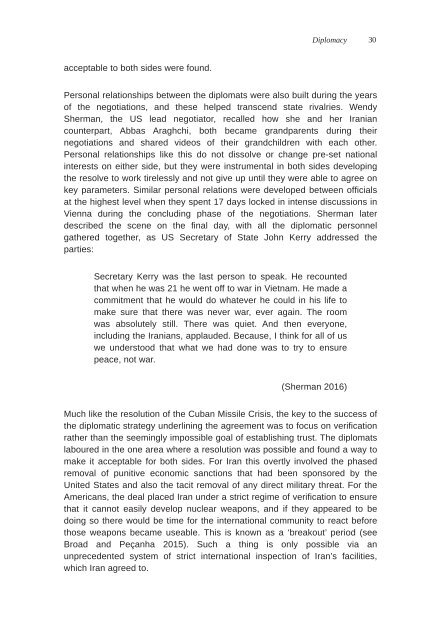International Relations
International-Relations-E-IR
International-Relations-E-IR
Create successful ePaper yourself
Turn your PDF publications into a flip-book with our unique Google optimized e-Paper software.
Diplomacy<br />
30<br />
acceptable to both sides were found.<br />
Personal relationships between the diplomats were also built during the years<br />
of the negotiations, and these helped transcend state rivalries. Wendy<br />
Sherman, the US lead negotiator, recalled how she and her Iranian<br />
counterpart, Abbas Araghchi, both became grandparents during their<br />
negotiations and shared videos of their grandchildren with each other.<br />
Personal relationships like this do not dissolve or change pre-set national<br />
interests on either side, but they were instrumental in both sides developing<br />
the resolve to work tirelessly and not give up until they were able to agree on<br />
key parameters. Similar personal relations were developed between officials<br />
at the highest level when they spent 17 days locked in intense discussions in<br />
Vienna during the concluding phase of the negotiations. Sherman later<br />
described the scene on the final day, with all the diplomatic personnel<br />
gathered together, as US Secretary of State John Kerry addressed the<br />
parties:<br />
Secretary Kerry was the last person to speak. He recounted<br />
that when he was 21 he went off to war in Vietnam. He made a<br />
commitment that he would do whatever he could in his life to<br />
make sure that there was never war, ever again. The room<br />
was absolutely still. There was quiet. And then everyone,<br />
including the Iranians, applauded. Because, I think for all of us<br />
we understood that what we had done was to try to ensure<br />
peace, not war.<br />
(Sherman 2016)<br />
Much like the resolution of the Cuban Missile Crisis, the key to the success of<br />
the diplomatic strategy underlining the agreement was to focus on verification<br />
rather than the seemingly impossible goal of establishing trust. The diplomats<br />
laboured in the one area where a resolution was possible and found a way to<br />
make it acceptable for both sides. For Iran this overtly involved the phased<br />
removal of punitive economic sanctions that had been sponsored by the<br />
United States and also the tacit removal of any direct military threat. For the<br />
Americans, the deal placed Iran under a strict regime of verification to ensure<br />
that it cannot easily develop nuclear weapons, and if they appeared to be<br />
doing so there would be time for the international community to react before<br />
those weapons became useable. This is known as a ‘breakout’ period (see<br />
Broad and Peçanha 2015). Such a thing is only possible via an<br />
unprecedented system of strict international inspection of Iran’s facilities,<br />
which Iran agreed to.


